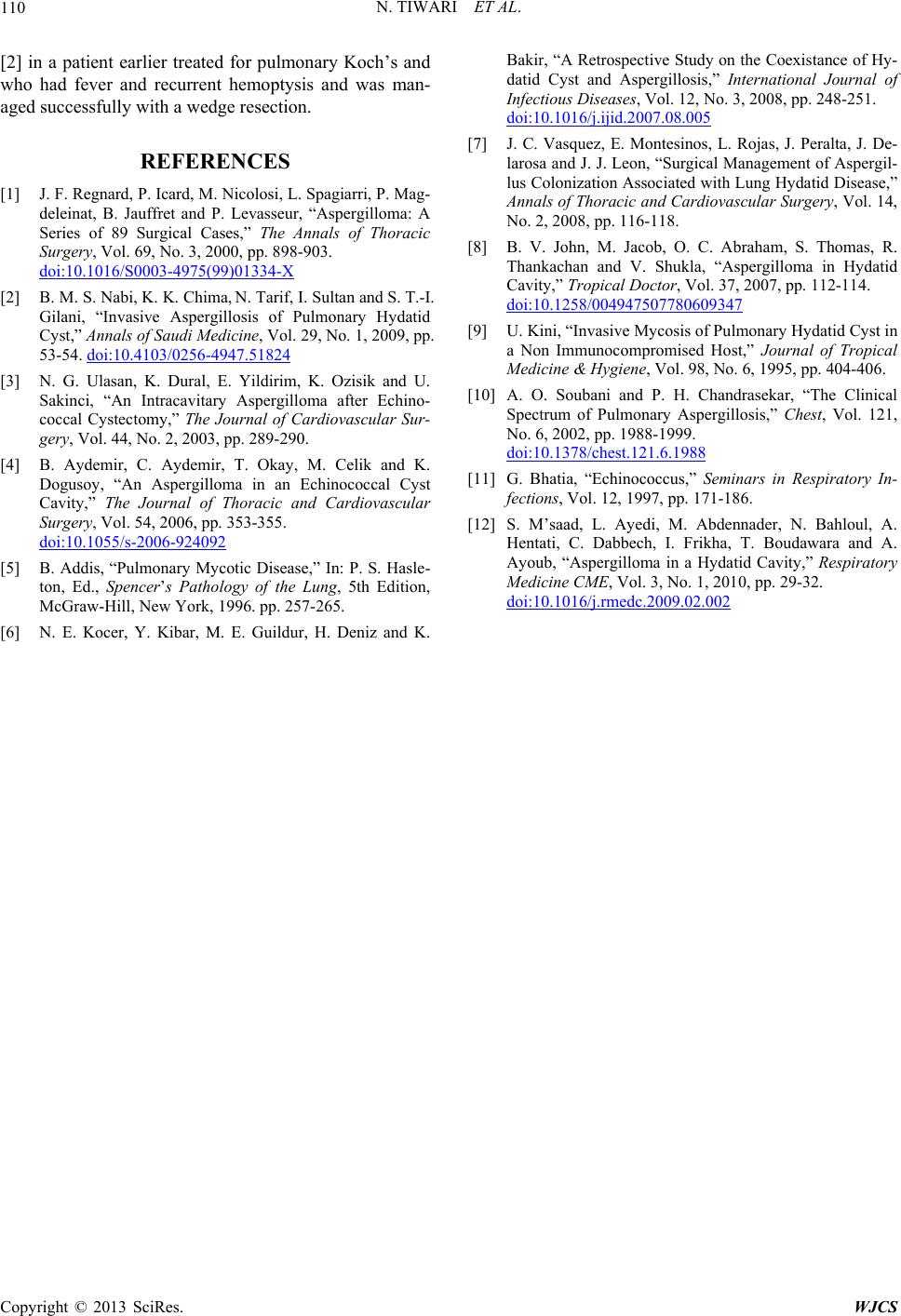
N. TIWARI ET AL.
Copyright © 2013 SciRes. WJCS
110
[2] in a patient earlier treated for pulmonary Koch’s and
who had fever and recurrent hemoptysis and was man-
aged successfully with a wedge resection.
REFERENCES
[1] J. F. Regnard, P. Icard, M. Nicolosi, L. Spagiarri, P. Mag-
deleinat, B. Jauffret and P. Levasseur, “Aspergilloma: A
Series of 89 Surgical Cases,” The Annals of Thoracic
Surgery, Vol. 69, No. 3, 2000, pp. 898-903.
doi:10.1016/S0003-4975(99)01334-X
[2] B. M. S. Nabi, K. K. Chima, N. Tar if, I. Su lta n and S. T.-I.
Gilani, “Invasive Aspergillosis of Pulmonary Hydatid
Cyst,” Annals of Saudi Medicine, Vol. 29, No. 1, 2009, pp.
53-54. doi:10.4103/0256-4947.51824
[3] N. G. Ulasan, K. Dural, E. Yildirim, K. Ozisik and U.
Sakinci, “An Intracavitary Aspergilloma after Echino-
coccal Cystectomy,” The Journal of Cardiovascular Sur-
gery, Vol. 44, No. 2, 2003, pp. 289-290.
[4] B. Aydemir, C. Aydemir, T. Okay, M. Celik and K.
Dogusoy, “An Aspergilloma in an Echinococcal Cyst
Cavity,” The Journal of Thoracic and Cardiovascular
Surgery, Vol. 54, 2006, pp. 353-355.
doi:10.1055/s-2006-924092
[5] B. Addis, “Pulmonary Mycotic Disease,” In: P. S. Hasle-
ton, Ed., Spencer’s Pathology of the Lung, 5th Edition,
McGraw-Hill, New York, 1996. pp. 257-265.
[6] N. E. Kocer, Y. Kibar, M. E. Guildur, H. Deniz and K.
Bakir, “A Retrospective Study on the Coexistance of Hy-
datid Cyst and Aspergillosis,” International Journal of
Infectious Diseases, Vol. 12, No. 3, 2008, pp. 248-251.
doi:10.1016/j.ijid.2007.08.005
[7] J. C. Vasquez, E. Montesinos, L. Rojas, J. Peralta, J. De-
larosa and J. J. Leon, “Surgical Management of Aspergil-
lus Colonization Associated with Lung Hydatid Disease,”
Annals of Thoracic and Cardiovascular Surgery, Vol. 14,
No. 2, 2008, pp. 116-118.
[8] B. V. John, M. Jacob, O. C. Abraham, S. Thomas, R.
Thankachan and V. Shukla, “Aspergilloma in Hydatid
Cavity,” Tropical Doctor, Vol. 37, 2007, pp. 112-114.
doi:10.1258/004947507780609347
[9] U. Kini, “Invasive Mycosis of Pulmonary Hydatid Cyst in
a Non Immunocompromised Host,” Journal of Tropical
Medicine & Hygiene, Vol. 98, No. 6, 1995, pp. 404-406.
[10] A. O. Soubani and P. H. Chandrasekar, “The Clinical
Spectrum of Pulmonary Aspergillosis,” Chest, Vol. 121,
No. 6, 2002, pp. 1988-1999.
doi:10.1378/chest.121.6.1988
[11] G. Bhatia, “Echinococcus,” Seminars in Respiratory In-
fections, Vol. 12, 1997, pp. 171-186.
[12] S. M’saad, L. Ayedi, M. Abdennader, N. Bahloul, A.
Hentati, C. Dabbech, I. Frikha, T. Boudawara and A.
Ayoub, “Aspergilloma in a Hydatid Cavity,” Respiratory
Medicine CME, Vol. 3, No. 1, 2010, pp. 29-32.
doi:10.1016/j.rmedc.2009.02.002